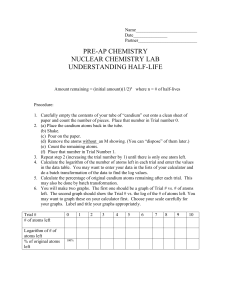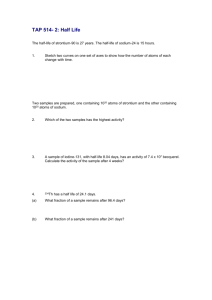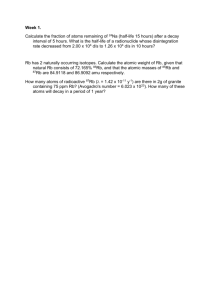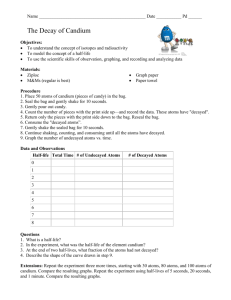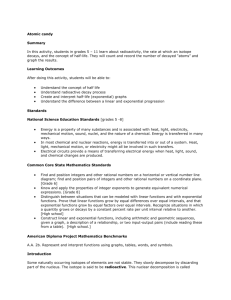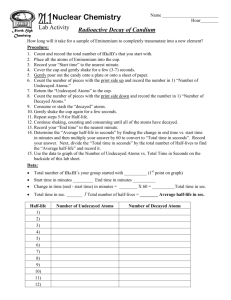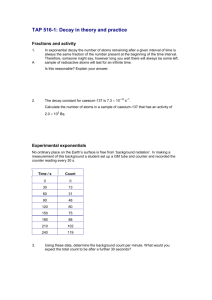UNDERSTANDING HALF-LIFE
advertisement
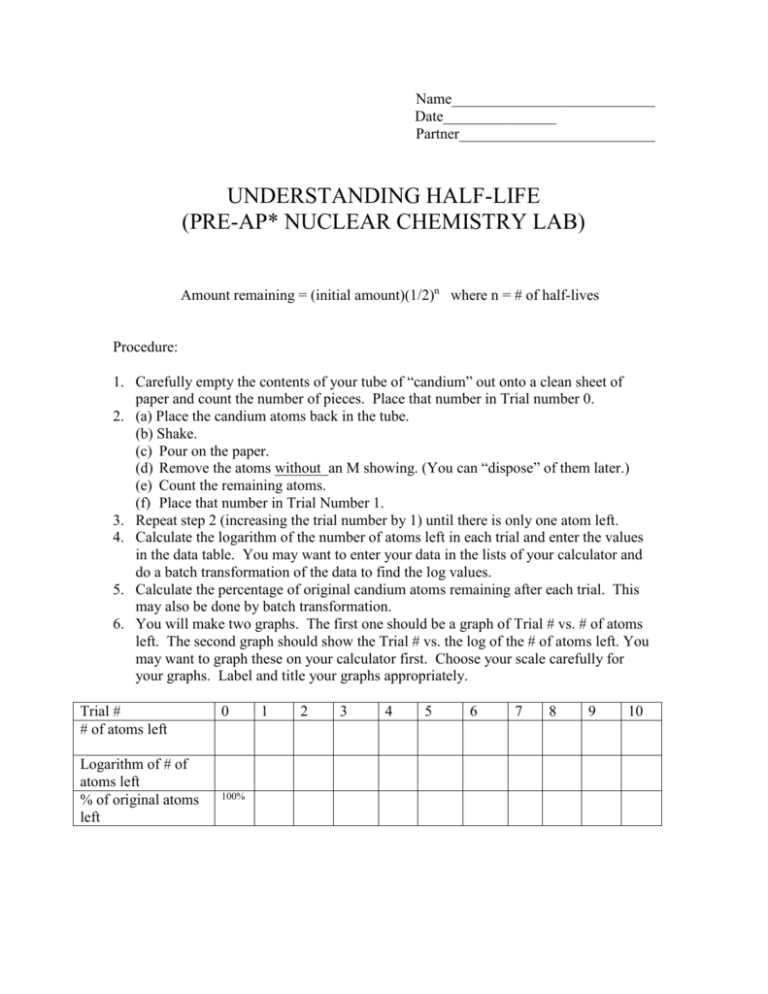
Name___________________________ Date_______________ Partner__________________________ UNDERSTANDING HALF-LIFE (PRE-AP* NUCLEAR CHEMISTRY LAB) Amount remaining = (initial amount)(1/2)n where n = # of half-lives Procedure: 1. Carefully empty the contents of your tube of “candium” out onto a clean sheet of paper and count the number of pieces. Place that number in Trial number 0. 2. (a) Place the candium atoms back in the tube. (b) Shake. (c) Pour on the paper. (d) Remove the atoms without an M showing. (You can “dispose” of them later.) (e) Count the remaining atoms. (f) Place that number in Trial Number 1. 3. Repeat step 2 (increasing the trial number by 1) until there is only one atom left. 4. Calculate the logarithm of the number of atoms left in each trial and enter the values in the data table. You may want to enter your data in the lists of your calculator and do a batch transformation of the data to find the log values. 5. Calculate the percentage of original candium atoms remaining after each trial. This may also be done by batch transformation. 6. You will make two graphs. The first one should be a graph of Trial # vs. # of atoms left. The second graph should show the Trial # vs. the log of the # of atoms left. You may want to graph these on your calculator first. Choose your scale carefully for your graphs. Label and title your graphs appropriately. Trial # # of atoms left Logarithm of # of atoms left % of original atoms left 0 100% 1 2 3 4 5 6 7 8 9 10 Questions: (Show work!) Helpful equation: Amount remaining = (initial amount)(1/2)n where n = # of half-lives 1. Is half-life a linear or a logarithmic relationship? (Hint: Which graph gave you a straight line?) 2. If you allowed 3 minutes between each trial, how long was the half-life of candium? 3. The half-life of sulfur-38 is 2.87 hours. a. After 8.61 hours, what percent of the original radiation is left? b. If 3.125% of the original radiation is being emitted, how many half-lives have passed? 4. Strontium-90 has a half-life of 28.8 years. How long will it take for a 5-count sample to decay to 0.3125 counts? 5. Germanium-66 has a half-life of 2.5 hours. After 10 hours, it only 25 counts of an original sample are emitted, what was the radiation of the original sample? 6. The half-life of carbon-14 is 5730 years. If a sample of wood containing 60 counts of carbon-14 when alive now only emits 3.75 counts, how old is the sample? 7. If you had started with a mole of candium atoms, how many would remain after 10 half-lives? 8. Iron-59 is used in medicine to diagnose blood circulation disorders. The half-life of iron-59 is 44.5 days. How much of a 2.000 mg sample will remain after 133.5 days? 9. EXTRA CREDIT CHALLENGE: After 2.00 years, 1.986 g of a radioisotope remains from a sample that has an original mass of 2.000g. a. Calculate the half-life of the radioisotope. b. How much of the radioisotope remains after 10.00 years? © 2004 by the Texas Education Agency Copyright © Notice. The Materials are copyrighted © and trademarked ™ as the property of the Texas Education Agency (TEA) and may not be reproduced without the express written permission of TEA, except under the following conditions: 1) Texas public school districts, charter schools, and Education Service Centers may reproduce and use copies of the Materials and Related Materials for the districts’ and schools’ educational use without obtaining permission from TEA. 2) Residents of the state of Texas may reproduce and use copies of the Materials and Related Materials for individual personal use only, without obtaining written permission of TEA. 3) Any portion reproduced must be reproduced in its entirety and remain unedited, unaltered and unchanged in any way. 4) No monetary charge can be made for the reproduced materials or any document containing them; however, a reasonable charge to cover only the cost of reproduction and distribution may be charged. Private entities or persons located in Texas that are not Texas public school districts, Texas Education Service Centers, or Texas charter schools or any entity, whether public or private, educational or non-educational, located outside the state of Texas MUST obtain written approval from TEA and will be required to enter into a license agreement that may involve the payment of a licensing fee or a royalty. For information contact: Office of Copyrights, Trademarks, License Agreements, and Royalties, Texas Education Agency, 1701 N. Congress Ave., Austin, TX 78701-1494; phone 512-463-7004; email: copyrights@tea.state.tx.us. *AP, Advanced Placement Program, and Pre-AP are registered trademarks of the College Board, which does not endorse nor was it involved in the production of this website. **Permission to excerpt AP materials does not constitute review or endorsement by the College Board, of these materials, or any questions or testing information they may contain.
